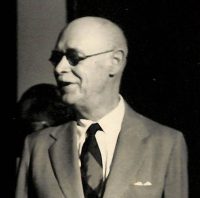When I saw the Cabinet today waiting patiently for the President to finish a talk in the Palace, I did not much envy them–especially when remembering that Quezon’s intention is not to share anything confidential with them (on account of Osmeña?) but to have an “inside cabinet” of his own–like the War Cabinet in England.
Roxas has been appointed head of the “Rice Commission” which relatively unimportant post he accepts with every show of pleasure after his recent encounter with Quezon’s will and a thorough drubbing.
Enaje has been appointed Adviser to the President on matters concerning judicial reorganization–an excellent choice, but small potatoes after his disappointments over the Speakership and Presidency of the Court of Appeals.
Doria tells me that the tradesmen try on her a regular racket of overcharging–to wit those who supplied conveniences for our tea dance–electrician, chair man and orchestry. She says it really frightens her, and she must get everything down in writing before hand. If, as Major Anderson told me, commercial morality had been enormously lowered in the United States since the war evidently similar influences are at work here.
Saw Osmeña for a few moments, handsome and smiling as of yore.
Professor Africa of the University of the Philippines, the head of the Department of Students of Foreign Relations, called on me to enquire whether the “supervision and control” of the United States over the foreign affairs of the Philippines prevented the establishment of separate Philippine Consulates. Told him I would get Quezon’s opinion, but my own opinion was that it could be done if Philippine Consuls were to deal only with Philippine ships, matters of citizenship and of commerce. I then told him of the question which the American judge at Shanghai recently asked me: “what am I to do if Filipinos now claim extraterritorial rights here?”
A. D. Williams came in to enquire whether there was any basis for Quezon’s newspaper statement that it was being considered whether to build main roads in Mindanao, or railroads, which would cost ten times as much and probably be a heavy loss. We agreed that roads were the modern solution, and that a railroad was only justified if leading to a mine or other heavy industry. He had told Quezon of the failure of the Bureau of Science to get a 6,000 peso machine to manufacture quinine for the Bukidnon plantation. Quezon took up the phone and ordered this done at once. Williams is greatly relieved that Quezon has now abandoned his plan of constructing another building opposite Malacañan–he has compromised on a chalet for tea parties constructed of Philippine woods, after the fashion of the forestry Exhibit at the Carnival.
Visit from Lacson, Iloilo lawyer, whom I asked what the Negros sugar planters were doing to prepare for the “sanctions” of the Tydings-McDuffie law? He replied, as they all do, “nothing, except to wait for a modification of that law–no effort is being made to lower costs of production and transportation–except talk of a harbour and wharf in Negros.” He said he had never been in favour of immediate, absolute independence; that the Visayans are all “Progresistas,” and the Tagalogs are for immediate independence. I asked him just what he meant–he replied “I am an Idealist–I want independence, but it is like wanting a beautiful woman–you want her all right, but if you have any sense, you count the cost.”
Dr Piguiging of Tanay called. He is going to work with the Bureau of Plant Industry and Bureau of Commerce on the Friar Lands question. Evidently Quezon is getting all the information he can on this subject.
Pedro Tan of Arayat and Major Santos, Assistant Chief of the Constabulary in Central Luzon called; both keen sportsmen. I asked them why the law against trapping and selling snipe was not enforced and Santos said because it added fuel to the flames of socialism–the peasants said the rich could shoot snipe and the poor couldn’t catch them. We agreed to try to get the snipe shooting season extended for next Autumn and Winter.
Santos told me of the rarity of the monkey-eating eagle of the Philippines. The British Museum had finally secured two specimens from a missionary priest in northern Luzon. Santos has one specimen, Jaronilla one and the University of Santo Tomas one. Santos also said he could prove that the “painted snipe” bred all the year around in the Philippines like the wild chicken. He believes that Balabac and Palawan had been part of Borneo at one time, as is shown by the existence of the peacock and mouse deer in those islands. Said he disapproved of “deer-sticking” in Jolo, because usually only the females and young were speared.
